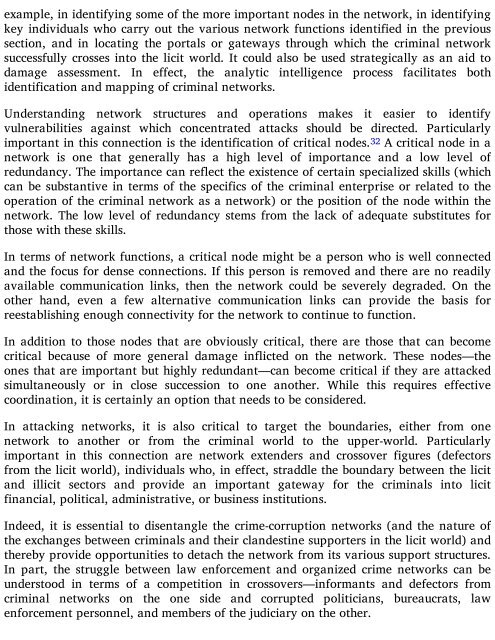RAND_MR1382
You also want an ePaper? Increase the reach of your titles
YUMPU automatically turns print PDFs into web optimized ePapers that Google loves.
example, in identifying some of the more important nodes in the network, in identifying<br />
key individuals who carry out the various network functions identified in the previous<br />
section, and in locating the portals or gateways through which the criminal network<br />
successfully crosses into the licit world. It could also be used strategically as an aid to<br />
damage assessment. In effect, the analytic intelligence process facilitates both<br />
identification and mapping of criminal networks.<br />
Understanding network structures and operations makes it easier to identify<br />
vulnerabilities against which concentrated attacks should be directed. Particularly<br />
important in this connection is the identification of critical nodes. 32 A critical node in a<br />
network is one that generally has a high level of importance and a low level of<br />
redundancy. The importance can reflect the existence of certain specialized skills (which<br />
can be substantive in terms of the specifics of the criminal enterprise or related to the<br />
operation of the criminal network as a network) or the position of the node within the<br />
network. The low level of redundancy stems from the lack of adequate substitutes for<br />
those with these skills.<br />
In terms of network functions, a critical node might be a person who is well connected<br />
and the focus for dense connections. If this person is removed and there are no readily<br />
available communication links, then the network could be severely degraded. On the<br />
other hand, even a few alternative communication links can provide the basis for<br />
reestablishing enough connectivity for the network to continue to function.<br />
In addition to those nodes that are obviously critical, there are those that can become<br />
critical because of more general damage inflicted on the network. These nodes—the<br />
ones that are important but highly redundant—can become critical if they are attacked<br />
simultaneously or in close succession to one another. While this requires effective<br />
coordination, it is certainly an option that needs to be considered.<br />
In attacking networks, it is also critical to target the boundaries, either from one<br />
network to another or from the criminal world to the upper-world. Particularly<br />
important in this connection are network extenders and crossover figures (defectors<br />
from the licit world), individuals who, in effect, straddle the boundary between the licit<br />
and illicit sectors and provide an important gateway for the criminals into licit<br />
financial, political, administrative, or business institutions.<br />
Indeed, it is essential to disentangle the crime-corruption networks (and the nature of<br />
the exchanges between criminals and their clandestine supporters in the licit world) and<br />
thereby provide opportunities to detach the network from its various support structures.<br />
In part, the struggle between law enforcement and organized crime networks can be<br />
understood in terms of a competition in crossovers—informants and defectors from<br />
criminal networks on the one side and corrupted politicians, bureaucrats, law<br />
enforcement personnel, and members of the judiciary on the other.










![Genki - An Integrated Course in Elementary Japanese II [Second Edition] (2011), WITH PDF BOOKMARKS!](https://img.yumpu.com/58322134/1/180x260/genki-an-integrated-course-in-elementary-japanese-ii-second-edition-2011-with-pdf-bookmarks.jpg?quality=85)
![Genki - An Integrated Course in Elementary Japanese I [Second Edition] (2011), WITH PDF BOOKMARKS!](https://img.yumpu.com/58322120/1/182x260/genki-an-integrated-course-in-elementary-japanese-i-second-edition-2011-with-pdf-bookmarks.jpg?quality=85)





